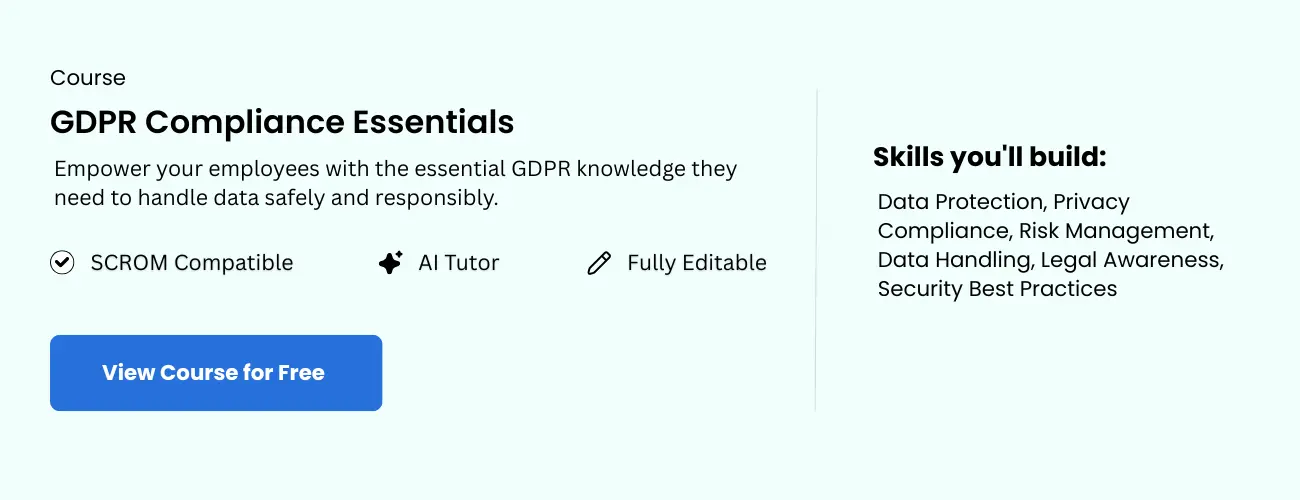
THANK YOU
FOR YOUR INFORMATION
One of our expert will be in touch with you…

Effective GDPR training empowers employees at every level to grasp their responsibilities in safeguarding personal data, fostering a strong privacy culture. As regulations evolve due to technological innovations and international standards, ongoing training including structured GDPR compliance training is essential. It helps organizations stay updated on compliance requirements, identify emerging risks, and adopt best practices for data security.
Data breaches and non-compliance can severely tarnish a company’s reputation and financial stability. According to the European Data Protection Board, GDPR fines can reach up to 4% of annual global turnover or €20 million, whichever is higher. Proactive, continuous GDPR training significantly mitigates these risks by ensuring staff are well-informed and responsive to evolving threats.
Maintaining GDPR compliance requires regular employee training to cultivate a privacy-aware culture. Establishing the right training frequency depends on factors such as industry standards, legal obligations, and organizational specifics. Understanding these elements enables organizations to develop effective training schedules that promote continuous awareness and compliance.
Training frequency varies across industries, often following initial comprehensive sessions with periodic refreshers. The International Association of Privacy Professionals (IAPP) reports that many companies conduct annual GDPR training to reinforce core principles and updates. This approach aligns with best practices globally and helps keep employees informed about the latest data protection trends.
While GDPR doesn’t prescribe precise training intervals, it emphasizes ongoing awareness. The European Data Protection Board (EDPB) advocates for continuous education instead of one-off sessions. The UK’s Information Commissioner’s Office (ICO) recommends tailoring ongoing education based on roles, risks, and data processing complexity. Regular refreshers—typically once a year—are considered prudent to ensure compliance and reduce breach risks.
Data protection authorities underline the importance of role-specific training and adapting to organizational changes. For example:
Dr. Ann Cavoukian highlights that nurturing a “privacy-aware culture” involves ongoing education tailored to emerging threats. Interactive and scenario-based training methods enhance retention, making regular (annual or semi-annual) refreshers highly effective.
Several variables affect training frequency, including:
These factors help organizations customize their training schedules for maximum impact.

Creating impactful GDPR training programs is crucial for ensuring employees understand and comply with data protection laws. Because GDPR compliance is complex and vital, organizations must deploy comprehensive, engaging, and measurable training initiatives. Well-designed programs minimize breach risks and foster a pervasive privacy mindset.
Different roles require tailored training approaches:
Active participation enhances learning and behavior change. Effective approaches include:
Assessment techniques include:
Ongoing training updates and refresher courses are essential for sustained GDPR compliance. Embedding training into data governance frameworks ensures privacy remains a continuous priority and not a one-time event.
Achieving GDPR compliance is an ongoing journey that must include regular, well-structured training. Keeping staff updated on regulatory changes, evolving threats, and best practices minimizes violations and cultivates a privacy-focused environment. Experts suggest conducting GDPR Compliance training at least once annually and supplementing it with updates whenever legislative or technological shifts occur.
Key actions include:
Prioritize ongoing GDPR education today to safeguard your organization’s reputation and build a resilient, compliant future.